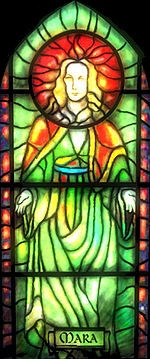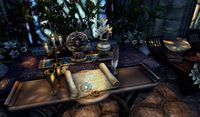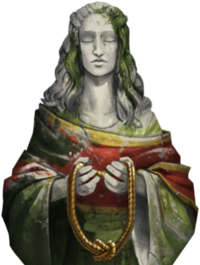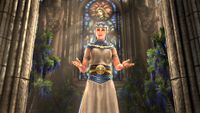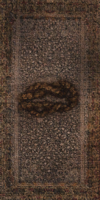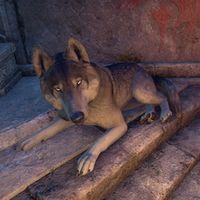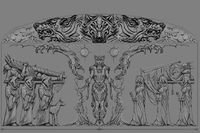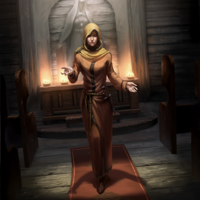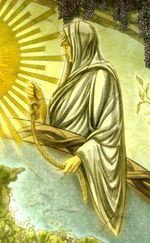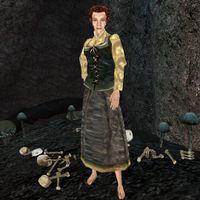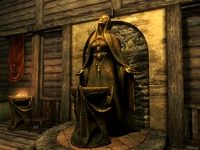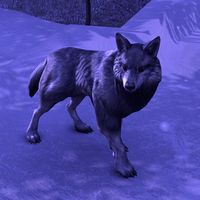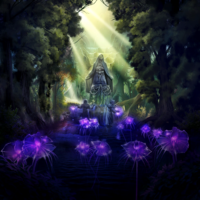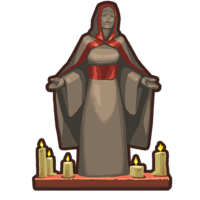Lore:Mara
- Come to me, Mara, for without you, I might forget the ways of our fathers, and preening by the light of latest fashion, my words might tremble like the thin reeds of novelty in the tempest of enthusiasms — Pocket Guide to the Empire, 3rd Edition
Mara, also known as Mother Mara,[1][2][3][4] Mother Mild,[5] and the Divine Mother,[1] is the Goddess of Love, Fertility, Agriculture,[6] and Compassion.[7] She is also acclaimed as the Mother-Goddess,[8] and is one of the Divines.[9]
In the Merethic Era, Mara was originally worshipped simply as a fertility goddess,[10] but the sphere of the Divine later extended to agriculture and love. Nir, the female principle of the cosmos credited as the mother of creation, is occasionally associated with Mara as a result of her role as the goddess of fertility and agriculture.[6] Mara is considered a near universal deity as the Divine is featured in the pantheons of all the races of the continent of Tamriel save the Dunmer and Argonians.[8]
Contents
Mythology[edit]
According to the creation myth presented in the Anuad, Mara and the Aedra (gods) were born from the mingled blood of Anu and Padomay, the good and evil primal forces, respectively, and therefore have a capacity for both good and evil, in contrast to the Daedra, who were born from the blood of Padomay, and thus are only evil.[11] The creation myth of the Khajiit acclaims Mara as the Mother Cat and describes the Divine as the daughter of Ahnurr (Anu) and Fadomai (Padomay).[12] The formation of Akatosh, the Dragon God of Time, from the mingled blood of the brothers Anu and Padomay facilitated the formation of Mara and the gods as they learnt to structure themselves.[13] Shezarr's Song, a Cyrodiilic creation myth, acclaims the creation of Mundus to the sacrifice of Mara and the gods whose sacrifices were embodied as eponymous planets.[14][15] Mara and the gods were subsequently bound to the Earth Bones as a result.[14] The moons of Masser and Secunda are claimed to be the embodiment of the lovers, a mortal woman named Mara and Shandar, respectively, as created by the Divine.[16]
Different cultures attribute different relationships between Mara and the other gods. The Nords of Skyrim consider Mara a handmaiden of Kyne and concubine of Shor (Lorkhan).[6] However, the Bretons, Altmer, and Bosmer consider Mara to be the wife of Akatosh or Auriel to the Elves.[10][17][18] Other faiths acclaim Mara as the wife of Lorkhan or concubine of Akatosh, or, in some cases, concubine of both.[8] In Ark'ay The God, Mymophonus the scribe claims that Mara deified Arkay, the God of Birth and Death, so to allow him to teach mortals the necessity of life and death.[2] In the First Era, the Divine punished Sai, God of Luck, and deprived him of his body for his failure to uphold his pact with Ebonarm, God of War, to spread luck throughout Tamriel in the gods' absence.[19] St. Alessia consulted Mara during her slave revolt against the Ayleids in the First Era.[20] The Warp in the West, also known as the Miracle of Peace, in 3E 417 is acclaimed as the work of Mara, Akatosh, and Stendarr.[21] It is unknown if Mara successfully destroyed the Skull of Corruption, a daedric artifact, in 4E 201.[22]
There are documented cases of Mara intervening, enabling the departed to briefly return as ghosts to share final moments with their loved ones and guide them beyond the mortal realm. This intervention extended even to situations involving individuals from different races with distinct beliefs about the afterlife. Notably, Mara facilitated the reunion of Nuralanya, a Corelanya Altmer, and an Orc named Gurlak in the afterlife.[23][24]
Teachings[edit]
As Goddess of Love, Mara is the bearer of love,[25] and shines the light of love on all mortals.[26] Mara gave life to mortals so that they may love.[27] The gift of love was bestowed upon mortals by the Divine so to honor Mara,[27] and allow them to understand the true nature of the Divines.[25] Mara teaches that love provides nourishment and life to all mortals.[25] The Divine commands mortals to "live soberly and peacefully. Honor your parents, and preserve the peace and security of home and family".[28] Mara's Benevolence is eternal and those who offer their love to the Divine will never be forsaken.[29] The Warmth of Mara shapes the destiny of mortals and can be felt across Tamriel.[29] Priests of Mara teach that the Divine is omnipresent and her love and affection can be found in the heart of all mortals, thus linking them to Mara.[30] The holy truth declares that love creates life and therefore those who love create more life.[27]
Mara is also the patron of marriage,[25] and the act of union is carried out at her shrines and temples.[31][32] The Divine teaches that the spark of union between two mortals comes from within and is not based on appearance.[25] The oaths and vows of marriage create life from love and are respected in the name of Mara.[27] The act of union is confirmed upon taking the Pledge of Mara and Mara does not place any restrictions on marriage, thus all may marry, irrespective of gender and race, and unite their souls in the holy union.[1] Mara makes her will known to her priests through visions[33] and commands them to aid those whose love needs guidance.[34] The priesthood of Mara strive to unite all mortals and are intolerant of those who are intolerant of others.[35] Mara's Prayer from the Doomed is a prayer recited in desperate situations.[36]
Worship[edit]
Worship in Black Marsh[edit]
The majority of the population of the province of Black Marsh venerate the Hist, and, in the Second Era, worship among the Argonians of Black Marsh of Mara and the gods was limited to a small minority of those who had assimilated to the culture of the Empire.[37] Imperial missionary efforts in the province in the Third Era were unsuccessful as missionaries died from local diseases, such as at Umpholo, where a Temple of Mara was constructed.[38] Mara is known to have been worshipped as a member of the pantheon of the Kothringi, the indigenous humans of Black Marsh, and was considered one of their three "mothers in the Around-Us", as well as Dibella and Kynareth.[UOL 1]
Worship in Cyrodiil[edit]
The Imperials of the province of Cyrodiil venerate Mara and the Divine is considered part of the Cyrodiilic pantheon.[8] A Benevolence of Mara, a cathedral dedicated to the Divine, was located in the Imperial City, the capital of the province, in the late First Era, under the Reman Dynasty.[39] In the 5th century of the Second Era, the Imperial City was also home to a Yokudan chapel in the Market District which contained a shrine to Morwha shaped like a beehive.[40] A Temple of Mara, and later Great Chapel of Mara, is known to have been located at Bravil in the Second and Third Eras, respectively.[41][42][43] In the late Third Era, wayshrines dedicated to the Divine can be found throughout the countryside.[44] At this time, the office of Archbishop of Mara is attested.[38] A wayshrine of Mara northwest of the city of Anvil was destroyed during the Oblivion Crisis in 3E 433.[44][45] In the same year, the Great Chapel of Mara at Bravil was desecrated by Aurorans, daedra in the service of Meridia, and several of its priests were killed.[46][43]
Although Ayleids followed the Daedra, the Aedra of Elven pantheon were still widely revered, with probably a majority of the Ayleids continuing to pay them homage, but cults devoted to the various Daedric Princes sprang up across Cyrodiil, tolerated and then celebrated.[47]
Worship in Hammerfell[edit]
The worship of Mara in the province of Hammerfell is divided between the Crowns, who represent the conservatives, and Forebears, who represent the cosmopolitan Redguards.[48] Mara is known to both Crowns and Forebears as Morwha, a fertility goddess, however, the names Morwha and Mara are used interchangeably among the Forebears.[49] Morwha is considered the favorite wife of Akatosh or Ruptga, to the Forebears and Crowns, respectively.[49] The goddess is always depicted with four arms so that she may "grab more husbands".[48] Mara is worshipped throughout Hammerfell, including the Island of Stros M'Kai,[49] and is the patron deity of the regions of Antiphyllos,[50] Ayasofya,[51] Ephesus,[52] and Ykalon.[53] In the late Third Era, similarly to High Rock, the Benevolence of Mara was responsible for the administration of temples dedicated to Mara and the Maran Knights was also active in the province at this time.[35][54] A Conservatorium of Morwha was located in the city of Hegathe in the late First Era.[55]
Worship in High Rock[edit]
Mara, a member of the pantheon of the Bretons,[8] is the patron deity of several regions of High Rock, such as Anticlere, Betony, Glenumbra Moors, and Northmoor.[56] It is said that villages which have clement weather year-round are protected by the Mother Goddess.[UOL 2] In Anticlere, the 21st of Last Seed was known as Appreciation Day, an ancient holiday of thanksgiving for a bountiful harvest. It was considered a holy and contemplative day devoted to Mara, the goddess-protector of the region.[57]
Nedic sculptures depicted coupled idols of an Elven Mara embracing a Mannish Lorkhan, seen as early evidence of Aldmeri culture being welcomed with open arms by the Manmer.[58] In the late Third Era, temples dedicated to the Divine were administered by the Benevolence of Mara, a religious organization dedicated to Mara and her teachings, and could be found in major urban centers throughout the province. The Benevolence of Mara was led by a patriarch and was allied to the Temple of Stendarr, a religious organization dedicated to Stendarr and his teachings.[35] The Maran Knights were a controversial knightly order dedicated to Mara and the protection of her temples. Some within the priesthood of Mara called for the disbandment of the order, while others argued the order was necessary to create peace.[54]
Worship in Morrowind[edit]
The Dunmer of Morrowind largely neglect worship of Mara and the Divines, however, in the late Third Era, worship of Mara and the Divines was practiced by a small minority of Dunmer on the Island of Vvardenfell. Worship of the Divine in Vvardenfell in the late Third Era was largely confined to its non-Dunmer population who prayed at shrines operated by the Imperial Cult, a missionary group, which combined worship of the Divines and provided services for all the Divines at shrines found at Imperial forts.[59] A shrine to Mara and the Divines was also located in the Royal Palace of Mournhold during this time.[60] Following the collapse of the Tribunal Temple in 3E 427, worshippers of Mara and the Divines formed the majority of Hlaalu and Vvardenfell districts.[61] In the Second Era, during the Three Banners War, shrines of Mara were located in the cities of Davon's Watch and Mournhold.[31]
Worship in the Reach[edit]
Circa 2E 582, two Reachfolk clans, Eagleseers and Six-Fords were to hold a handfasting upon an altar of Mara at Hroldan Ring to unite the two clans, but it is unknown if they actually worshiped Mara herself.[62] One of the direwolves kept in the Shrine of the Hunt-Father's grounds was named after Mara.[63]
After imperialization and the loss of independence, some Reachmen embraced the worship of the Eight Divines, including Mara, believing that certain aspects of their traditional practices were best left in the past.[64][65][66] As of 4E 201 several Reachfolk accept marriage under Mara.[32] Spirits of Briarhearts, whose original hearts were defiled are unable to pass to the afterlife,[67][68] unless the original heart of the deceased Briarheart is purified at the shrine of Mara and properly buried.[69]
Worship in Skyrim[edit]
The Divine is also worshipped as a member of the Nordic pantheon.[8] The Sacred Wolf was one of the most revered Atmoran animal totems, associated by later Nords with the goddess Mara,[70] who was known as Mother Wolf.[71][72] In the Second Era, Mara was associated with the Ice Wolves that inhabited the mouth of the White River in the northeast of the province.[73] Wooden figures of Mara depict a naked woman partially clothed in wolf pelts who bears fangs of her own, similar to Atmoran stone carvings.[74]
Worship of Mara in the province of Skyrim was widespread in the Fourth Era and shrines dedicated to the Divine could be found both in the wilderness and in urban centers, such as at the Temple of the Divines in Solitude,[75] and at the Temple of Mara in Riften.[76] Shrines dedicated to Mara usually have flower-spouting fertility statuettes.[77] A pond in the hold of Eastmarch was named after Mara.[78] Some argued the return of the dragons in 4E 201 was a sign from Mara signalling her displeasure with the people of Skyrim.[79]
To Nordic traditionalists, Mara takes a lesser role in the pantheon, considered to be Kyne's handmaiden, and one of Shor's concubines.[6][UOL 3] Her worship tends to be more emphasized in areas with a large Imperial influence. Amulets of Mara are frequently worn to indicate that someone is looking to marry, as life is hard and full of hardship in Skyrim courtships tend to be very short. Marriages are often held in Riften's Temple of Mara.[79]
Worship in the Summerset Isles[edit]
Mara is worshipped in the High Elven pantheon.[18] An Altmer legend tells that Nenamil, the Archon of Song, once embarked on a pilgrimage to see Mara's beauty in person, believing that the greatest love he could feel was love for the mother of creation. His journey eventually took him to what is now known as Archon's Grove, where he found a flower of surpassing beauty, the so-called Rose-of-Archon. Upon seeing the flower, he realized that Mara was more than just a being: she was beauty incarnate, found in every exquisite thing. From then on, Nenamil would preach Mara's beauty and the Rose-of-Archon would honor and represent her. Roses-of-Archon are collected by the Sapiarchs for the Divine Reverence to Mara, a ceremony that lasts for at least fifty-eight days.[80]
Artifacts[edit]
During the Three Banners War in the Second Era, a Temple of Mara located in the town of Bravil, Cyrodiil, was home to several holy relics of Mara, including a chalice, phylactery, dagger, and circlet. The Chalice of Mara was alleged to have been a wedding gift from Mara to St. Alessia, founder of the Alessian Empire, at her wedding to Morihaus.[81] In 2E 582, the Sphinxmoth Bandits, a group of bandits operating from the neighboring Fort Sphinxmoth, looted the temple of its valuables, including the relics. The bandits were defeated by the Vestige and the relics were subsequently returned to the temple.[82] In 3E 427, on the Island of Vvardenfell, the Divine appeared before the Nerevarine as an apparition in the form of a Breton woman named Ama Nin and gifted the Nerevarine her blouse and skirt.[83] Some claim the Everflow Ewer was created by Mara.[84]
Of the Crusader's Relics, it is unknown whether Mara created the Cuirass or Greaves of the Crusader. The Crusader's Relics are a set of artifacts created by the Divines in the early First Era for Pelinal Whitestrake, the Divine Crusader, to allow him to defeat and banish Umaril the Unfeathered, an Ayleid Sorcerer King. Regardless, Pelinal, despite his victory over Umaril, was slain and the Crusader's Relics were scattered and lost for thousands of years.[85] The Cuirass of the Crusader was held by the Wyrm of Elynglenn in Cyrodiil until recovered by Sir Amiel Lannus, a member of the chivalric order the Knights of the Nine, in 3E 111.[86] The cuirass was stored in the undercroft of the Priory of the Nine, where it lay until recovered by the Hero of Kvatch in 3E 433.[87] The Greaves of the Crusader were recovered by Sir Berich Vlindrel and were buried with him in the Vlindrel family tomb, but was later recovered by Sir Roderic of Wayrest and his squire Lathon, who gifted the greaves to the Hero of Kvatch.[88]
Mara's Blouse[edit]
Mara's Blouse is a piece of clothing associated with the Goddess of Love, Mara. It is a red blouse imbued with magical properties that protect the wearer from the effects of hostile spells.
Mara's Skirt[edit]
Mara's Skirt is a piece of clothing associated with the Goddess of Love, Mara. It is a red skirt imbued with magical properties that improve the vitality and health of the wearer.
Planet[edit]
The planet Mara, sometimes called MHARA, is one of the Planets in the skies of Mundus, and according to the Warrior-Poet, Vivec, is one of the eight worlds known to the Dwemer. Mara is Zenithar's satellite and is orbiting around it, while Dibella is orbiting around Mara. As with all astral bodies bodies seen in the skies above Nirn and their corresponding deities, the planet Mara is believed to be the plane of the goddess Mara as well as the goddess herself, as seen from the mortal plane. It is said to actually be a different plane of existence in its own right, infinite in size and mass, with its appearance as a sphere being only a visual phenomenon caused by mortal mental stress.
Gallery[edit]
-
Ama Nin, a manifestation of Mara (Morrowind)
-
The White River Ice wolves are commonly associated with Mara[89] (ESO)
Notes[edit]
- Mara lends her name to an alcoholic beverage known as the Bloody Mara.[90]
- Some view certain breeds of Tamriel's hens laying colorful eggs in pastel colors in Spring as a sign of the blessing of Mara.[91]
- The word for "relating to Mara" is "Maran".[54]
- Mara was named after Daggerfall beta tester Marilyn Wasserman.
Books[edit]
- The Heart of Love — A short text on the god Mara
- Praise Be — A religious hymn honoring various Aedra
- The Green Singing — The ritual incantation of a Spinner of Y'ffre
- Mara's Tear by Zhen — An origin myth for the two moons, Mara's Tear and Shandar's Sorrow
- Varieties of Faith in Tamriel by Brother Mikhael Karkuxor of the Imperial College — Description of the pantheons of gods in Tamriel
- Heart's Day Mass Wedding by Loremaster Lawrence Schick — A special reading from a Heart's Day event
- A Cat's Serenade — (A Khajiiti Love Song)
References[edit]
- ^ a b c Artorius Ponticus Answers Your Questions — Bishop Artorius Ponticus
- ^ a b Ark'ay The God — Mymophonus the Scribe
- ^ The Improved Emperor's Guide to Tamriel: Skyrim — Flaccus Terentius, 2E 581
- ^ Loremaster's Archive: Murkmire Q&A Part 2 — Jee-Lar
- ^ Guide to Bravil — Alessia Ottus
- ^ a b c d Varieties of Faith: The Nords — Brother Mikhael Karkuxor of the Imperial College
- ^ Loading screen in Skyrim
- ^ a b c d e f Varieties of Faith... — Brother Mikhael Karkuxor of the Imperial College
- ^ The Talos Mistake — Leonora Venatus
- ^ a b Varieties of Faith: The Bretons — Brother Mikhael Karkuxor of the Imperial College
- ^ The Annotated Anuad
- ^ Words of Clan Mother Ahnissi — Clan Mother Ahnissi
- ^ The Monomyth
- ^ a b Aedra and Daedra
- ^ The Orrery in Oblivion
- ^ Mara's Tear — Zhen
- ^ Varieties of Faith: The Wood Elves — Brother Mikhael Karkuxor of the Imperial College
- ^ a b Varieties of Faith: The High Elves — Brother Mikhael Karkuxor of the Imperial College
- ^ King Edward, Part X — Anonymous
- ^ The Song of Pelinal, v 2
- ^ The Warp in the West — Ulvius Tero
- ^ Events of Waking Nightmare in Skyrim
- ^ Nuralanya's dialogue in ESO
- ^ Events of The Oldest Orc in ESO
- ^ a b c d e Dinya Balu's dialogue in Skyrim
- ^ Briehl's dialogue in Skyrim
- ^ a b c d Heart's Day Mass Wedding — Loremaster Lawrence Schick
- ^ Ten Commands: Nine Divines
- ^ a b The Warmth of Mara
- ^ The Heart of Love
- ^ a b Ritual of Mara in ESO
- ^ a b Events of The Bonds of Matrimony in Skyrim
- ^ Erandur's dialogue in Skyrim
- ^ The Book of Love in Skyrim
- ^ a b c Faction information for the Benevolence of Mara in Daggerfall
- ^ The Refugees — Geros Albreigh
- ^ Varieties of Faith: The Argonians — Brother Mikhael Karkuxor of the Imperial College
- ^ a b The Argonian Account, Book 4 — Waughin Jarth
- ^ 2920, Morning Star — Carlovac Townway
- ^ Crafting Motif 6: Redguard Style — Doctor Alfidia Lupus
- ^ Daughter of the Niben — Sathyr Longleat
- ^ Events of Prisoners of the Sphinx in ESO
- ^ a b Great Chapel of Mara in Oblivion
- ^ a b Wayshrines in Oblivion
- ^ Events of Dagon Shrine in Oblivion
- ^ Events of Nature's Fury in Oblivion
- ^ Daedra Worship: The Ayleids — Phrastus of Elinhir
- ^ a b Varieties of Faith, Crown Redguards — Brother Mikhael Karkuxor of the Imperial College
- ^ a b c Varieties of Faith, The Forebears — Brother Mikhael Karkuxor of the Imperial College
- ^ Antiphyllos in Daggerfall
- ^ Ayasofya in Daggerfall
- ^ Ephesus in Daggerfall
- ^ Ykalon in Daggerfall
- ^ a b c Faction information for the Maran Knights in Daggerfall
- ^ 2920, Sun's Height — Carlovac Townway
- ^ Patron deities of Anticlere, Betony, Glenumbra Moors and Northmoor in Daggerfall
- ^ Holidays in Daggerfall
- ^ Manmer Coupled Idol codex entries in ESO
- ^ Imperial Cult's presence and members in Morrowind
- ^ Imperial Cult Shrine in Morrowind: Tribunal
- ^ A Life of Uriel Septim VII — Rufus Hayn
- ^ Vows and Oaths quest in ESO
- ^ Mara in ESO: Markarth
- ^ Belchimac's dialogue in Skyrim
- ^ Cedran's dialogue in Skyrim
- ^ Degaine's dialogue in Skyrim
- ^ Beldama Witch's Note
- ^ Crypt of the Heart - Draft — Ariana Dumas
- ^ Events of Crypt of the Heart quest in Skyrim
- ^ Frostbane Wolf's description in ESO
- ^ Taxidermied Wolf and Suckling Cubs
- ^ Old Mjolen's dialogue in ESO
- ^ White River Ice Wolf Pup's description in ESO
- ^ Wolf Mara Figure description
- ^ Temple of the Divines in Skyrim
- ^ Temple of Mara in Skyrim
- ^ Mara Fertility Fetish description
- ^ Mara's Eye Pond in Skyrim
- ^ a b Maramal's dialogue in Skyrim
- ^ Justiciar Tanorian's dialogue in ESO: Summerset
- ^ Marcella Ammianus' dialogue in ESO
- ^ An Affront to Mara quest in ESO
- ^ Boots of the Apostle quest in Morrowind
- ^ Knightfall — Jaren Aethelweald, edited by Kirellian Odrenius
- ^ The Knights of the Nine — Karoline of Solitude
- ^ Sir Amiel's Journal — Sir Amiel
- ^ Events of Priory of the Nine in Oblivion
- ^ Events of The Faithful Squire in Oblivion
- ^ White River Ice Wolf Pup description in ESO
- ^ Purifying Bloody Mara beverage in ESO
- ^ Mara's Spring Chicken description in ESO
Note: The following references are considered to be unofficial sources. They are included to round off this article and may not be authoritative or conclusive.
|
|||||||||||||||||
|
|||||||||||
|
|||||||||||
|
||||||||||||||||||||||||||
|
|||||||||||||||||||||||
|
||||||||||||||||||||||||||||||||
|
|||||
|
||||||||||||||||||||||||||||||
|
||||||||||||||||||||||||||||||||||||
